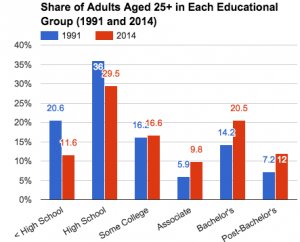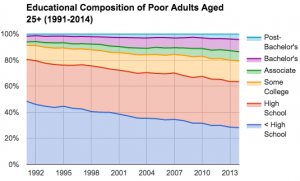Why Education Does Not Fix Poverty
为什么教育不能解决贫困问题
作者:Matt Bruenig @ 2015-12-2
译者:龟海海
校对:小册子(@昵称被抢的小册子)
来源:Demos,http://www.demos.org/blog/12/2/15/why-education-does-not-fix-poverty
Brookings and the American Enterprise Institute claim to have hatched a bipartisan consensus plan for reducing poverty. As exciting as that sounds, the details of the plan, unfortunately, won’t be available until David Brooks unveils them at an event on December 3rd. Nonetheless, it’s clear from the materials they have released that the consensus plan will focus on three things: education, marriage, and work.
布鲁金斯学会和美国企业协会声称已研究出一个双方都认同的计划来减少贫困【编注:布鲁金斯学会和美国企业协会分别是美国自由派和保守派阵营最具影响力的智库】。尽管听起来很令人激动,但不幸的是,David Brooks要等到12月3日的一个活动上才会公布这个计划的详情。尽管如此,根据他们之前所公布的一些资料,他们的共同计划将主要集中在三个方面:教育,婚姻和工作。
In the next few posts, I will attack all three focuses as misguided. Today’s focus will be on education, easily the most misguided of the three.
在随后的文章中我会逐步抨击所有这三个误导性的焦点。今天我将说一说教育,也是三个中最具误导性的。
1. Rehearsing the Education Poverty Argument
1. 回顾教育改变贫穷的观点
To see where the education poverty argument goes wrong, it’s helpful to explain what that argument is first. In this post, I am going to do that by pretending initially that we are in the year 1991. That year has no special significance other than that it’s the year the modern Census education questions begin.
要看清这个教育改变贫穷的观点哪里不对劲,有必要先解释一下这个观点是什么。在本文中,我会首先假装我们生活在1991年。那一年除了人口普查中开始出现教育相关问题,没有什么特别的事件。
So imagine you are an education-focused poverty person living in 1991. You peer out into the world of basic social statistics and you see this graph of adult poverty rates broken down by education:
那么我们来想象一下,你生活在1991年,并且关注通过教育改变贫穷。你往基础社会统计的世界里张望,看到这幅按教育程度统计的成人贫穷率图表:
You notice something very striking about the graph: the higher the education, the lower the poverty rate.
You go back out into the social statistics universe and you see this graph breaking down the distribution of adults across the various educational groups:
你在该图表里发现一些很令人震惊的东西:学历越高,贫困率越低。
然后你再回到社会统计领域之中,看到这幅成年人的教育程度分布图:
You combine this graph with the poverty rate graph in your mind and you have an epiphany. Because the lower educational bins have higher poverty rates and the higher educational bins have lower poverty rates, if we change the composition of adults such that a greater percentage of them wind up in the higher educational bins, that will mean lower overall poverty.
你把该图和之前的贫穷率图表综合起来,然后你瞬间顿悟。因为低学历的格子里有较高贫困率,高学历的格子里有较低贫困率,如果我们把成年人的组成换一换,多一点人落入较高学历的格子里,那总体的贫困率就会降低。
So, for instance, if we could move 9 points off the “less than high school” bar and on to the “associate” (or better) bars, we would definitely see lower poverty. After all, you are moving people out of a high poverty bin and into low poverty bins. Similarly, if you could move 6.5 points of the “high school” bar and on to the “associate” (or better) bars, you’d see lower poverty for the same reason.
举个例子,如果我们把“低于高中”中的9个百分点,移动到“大专”(或以上)的格子里去,我们肯定会看到更低的贫困率。总之,你是在把人从高贫困率的格子里,移动到低贫困率的格子里去。类似的,如果你能把“高中”中的6.5个百分点,移动到“大专”(或以上)的格子里,你同样会看到更低的贫困率。
2. It Didn’t Work
2. 然并卵
Since 1991, we have done precisely what the education-focused poverty people said to do. Between 1991 and 2014, we steadily reduced the share of adults in the “less than high school” and “high school” bins and increased the share of adults in every other bin:
从1991年起,我们完全按照这帮关注教育改善贫穷的人所说的去做。在1991年和2014年之间,我们稳步降低了成人中“低于高中”和“高中”的比率,令其他人群比率提高:
By 2014, the share of adults in the “less than high school” bin declined 9 points from 20.6% to 11.6%. The share of adults in the “high school” bin declined 6.5 points from 36% to 29.5%. Meanwhile, the share of adults with an Associate degree went up 3.9 points, the share with a Bachelor’s degree went up 8.3 points, and the share with a post-Bachelor’s degree went up 4.8 points.
截至2014年,成年人中“低于高中”这部分已经降低了9个百分点,从20.6%降到了11.6%。成年人中“高中”这部分下降了6.5个百分点,从36%降到了29.5%。同时成年人中拥有大专学历的上涨了3.9个百分点,拥有学士学位的上涨了8.3个百分点,拥有学士以上学历的增长了4.8个百分点。
If the poverty rates for each educational bin remained the same, then the upward redistribution of adults from the lower bins to the higher bins would have led to lower overall poverty. But that’s not what happened.
如果各个教育层次的贫困率都保持不变,将成年人从低学历移向高学历应该导致整体贫困率下降才是。但是,这却并未发生。
Instead, the poverty rate for each educational bin went up over this time and overall poverty didn’t decline at all. In fact it went up.
实际上,各个教育层次的贫困率在这一时期都上升了,总体贫困率根本没有降低,反而是上升了。
By 2014, the “less than high school” poverty rate had increased 3.7 points. The “high school” poverty rate increased 4.6 points. “Some college” went up 4.1 points, “associate” went up 3.8 points, “bachelor’s” went up 2.1 points, and “post-bachelor’s” went up 1.7. Despite the educational gains, overall adult poverty in 2014 was actually 1.1 points higher than in 1991.
截至2014年,“低于高中”这栏的贫困率提高了3.7个点。“高中”的贫困率增长4.6个点。“专科院校”增长了4.1个点,“大专”上升3.8个点,“学士”增长2.1点,“学士以上”上升1.7点。尽管学历水平得到提高,但2014年的总体贫困率却比1991年高了1.1个点。
As the adults migrated up the educational bins, they took the poverty into the higher educational bins with them:
随着教育程度提高,成年人把贫困也带入了更高的教育程度之中:
Over this period, the share of poor adults with “less than high school” education plummeted 20.1 points from 48.3 points to 28.2 points. Every other educational bin saw share gains of 2.6 to 5 points.
在这期间,贫困成年人中“低于高中”文化水平的占比大跌了20.1个点,从48.3%降到了28.2%。其余每个教育程度都大约增长了2.6到5个点。
Adults these days are as educated as they have ever been, but poverty is no lower than it was in 1991. This is not because the few lingering people with “less than high school” have soaked up all the poverty. Quite the contrary: poverty has simply moved up the educational scale. The poor in 2014 were the most educated poor in history.
如今成年人的教育程度空前之高,但是贫困率并不比1991年低。这不是因为少数学历“低于高中”又游手好闲的人占据了贫困。正好相反,贫困问题在向高教育程度人群转移。2014年的贫困人口是有史以来教育程度最高的。
3. Why It Doesn’t Work
3. 为什么没有用
There are a number reasons why aggregate education gains do not necessarily translate into aggregate poverty declines. I will discuss three here.
总体教育程度提高未必转化为总体贫困率下降,这当中有很多原因。我在此说三点。
First, handing out more high school and college diplomas doesn’t magically create more good-paying jobs. When more credentials are chasing the same number of decent jobs, what you get is credential inflation: jobs that used to require a high school degree now require a college degree; jobs that used to require an Associate degee now require a Bachelor’s degreee; and so on.
第一,发出更多的高中和大学文凭并未能像变魔术般的创造出更多高薪工作。当更多更闪耀的文凭来争夺同样多的好工作时,你得到的是文凭通胀:那些本来要求高中文凭的工作现在要求大学文凭;那些本来要求大专学历的工作现在要求本科学历,依此类推。
Obviously the supply of good-paying jobs is not a fixed constant of nature, but there is no reason to think that the supply will automatically go up to match the number of people with the necessary credentials. The types of jobs available in a society, and their level of compensation, is determined by many factors (demand, worker power, technology, global competition, natural resources, etc.) that have little to do with the number of degrees that society is minting.
显然,好工作的供给并非一成不变,但也没有理由相信好工作会随着合格的文凭增多而增多。社会中的工作类别,以及薪金水平,是由很多因素决定的(需求,工会力量,技术,全球竞争,自然资源,等等),这些因素和社会上颁发的文凭数量并没有多大关系。
Second, having more education does not necessarily increase people’s productive capacity. Those in the know will identify this as the old “signaling v. human capital” point. The short of it is that, even if jobs did automatically pop into existence to match people’s level of productive ability, it’s not at all clear that college education necessarily does a lot to increase people’s productive ability. Instead, what college education does (at least in part) is signal to employers that you have a certain level of relative “quality” over others in society.
第二,接受更多教育并不意味着更高的生产率。内行人会发现这是古老的“信号传递对人力资本”理论的要点【编注:这是解释教育程度与薪酬水平关系的两种理论,前者认为文凭传递了有关个人禀赋的信号,后者认为教育确实提升了人力资本的生产率】。简单地说,即使自动会有工作职位来匹配人们的产出能力水平,大学教育是否对提高人们的产出能力有很大作用也完全不明确。而大学教育所做的是(至少一部分是)向雇主发出一个信号:你相比社会上其他的人“优秀”一些。
As more people get degrees, the value of this signal declines, but more importantly, the point is that the degree was always a signal, not a productivity enhancer.
然而,当越来越多的人拿到文凭时,这个信号就变弱了,更重要的是,文凭永远只是一个信号,并非产出能力的推进器。
Third, poverty is really about non-working people: children, elderly, disabled, students, carers, and the unemployed. The big things that cause poverty for adults over the age of 25 in a low-welfare capitalist society—old-age, disability, unemployment, having children—do not go away just because you have a better degree.
第三,贫困的是那些不工作的人:孩子,老人,残疾人,学生,照顾家人者和无业者。在一个低福利资本主义社会,导致25岁以上成年人贫困的罪魁祸首——老龄化,残疾,失业,育儿——不会仅仅因为你有了个更好文凭而消失。
These poverty-inducing circumstances are social constants that could strike anyone of us and do strike many of us at some point in our lives. To the extent that education does nothing to provide better income support for those who do find themselves in these vulnerable situations, its effect on overall poverty levels will always be weak, or, as with the US in the last 23 years, totally nonexistent.
这些导致贫穷的境况在社会中总是存在的,我们每个人都有可能遇到,并且必定有很多人在生命中的某一个时刻会遇到。既然教育不能帮助那些身处窘境的人们或得更多收入,那它对整体贫困水平的影响就必然很微弱,或者正如在美国过去23年的情况那样,根本不存在。
******
Technical note. For this post, I used the Official Poverty Metric (OPM) to measure poverty. This is mainly because it’s the only metric for which publicly accessible microdata exists back to 1991. The OPM is deeply flawed because it excludes from its calculation taxes, tax credits, and non-cash benefits like WIC, Section 8, and Food Stamps.
技术性注解:在本文中,我运用了官方贫困数据(OPM)来量化贫困,主要是因为这是唯一公众可以查找到的1991年前的微观数据。由于没有考虑所得税、税收抵免,以及包括低收入妇女儿童健康营养补助,《住房法案》第八章下的住房补贴和食物救济券在内的非现金福利,该OPM数据有很大的缺陷。
Because the alleged poverty-reducing mechanism of higher educational attainment is that it increases market income (not welfare income or income from refundable tax credits), the OPM’s flaws are not really relevant here. In short, the OPM, despite its problems, works perfectly fine here.
因为所谓高学历可以减少贫困的观点着眼于提高市场收入(而非福利收入或税收抵免返还),所以与OPM的缺陷并不相关。简而言之,尽管OPM有所不足,但在这里引用绝对没有问题。
(编辑:辉格@whigzhou)
*注:本译文未经原作者授权,本站对原文不持有也不主张任何权利,如果你恰好对原文拥有权益并希望我们移除相关内容,请私信联系,我们会立即作出响应。
——海德沙龙·翻译组,致力于将英文世界的好文章搬进中文世界——

 订阅
订阅







暂无评论
发表评论